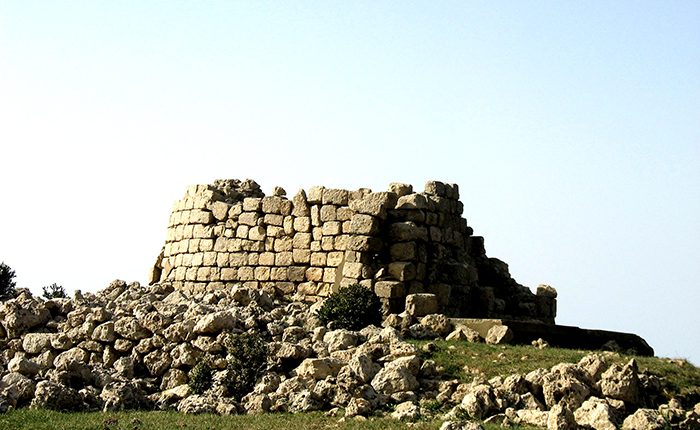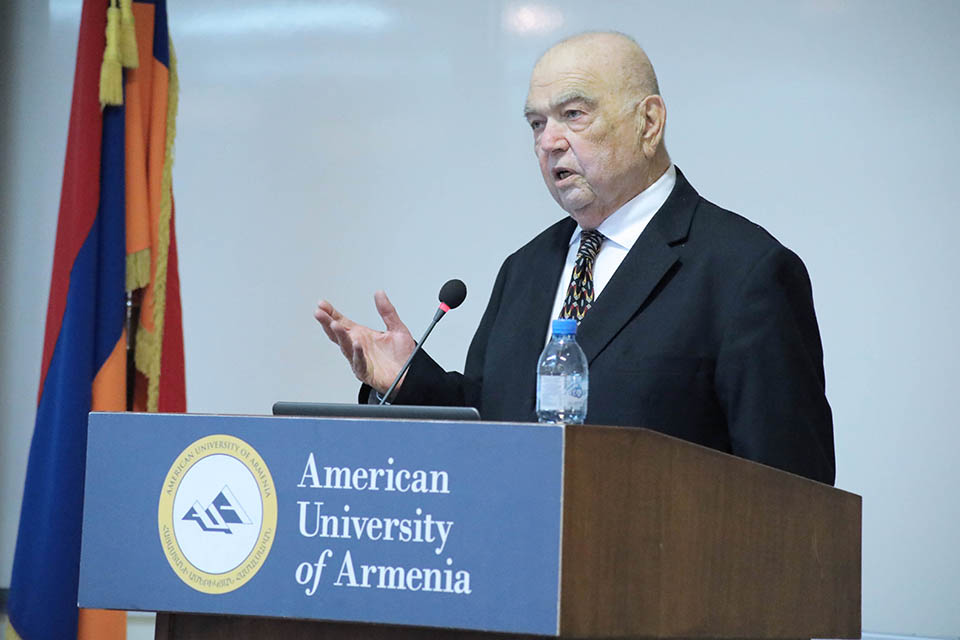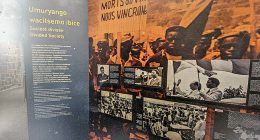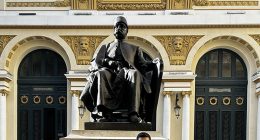By VAHRAM L. SHEMMASSIAN, Ph.D.
The first anniversary of the Musa Dagh resistance to the Genocide was marked in 1916 at the Armenian refugee camp of Port Said, Egypt, which was established the year before to shelter the Armenian highlanders from Musa Dagh after their rescue by the French navy. When the refugees returned home by fall 1919, regional insecurity prevented them from marking the saga with public grandeur till 1924. Each year thereafter, through 1938, commemorative events took place at Damlajik, where a pile of rocks had served as a makeshift altar during the actual fights. For about eight years Holy Mass was celebrated at this site, and requiem for the repose of those who had fallen on the battlefield was conducted in a nearby plot, where wooden crosses were stuck into the ground. But in 1932, this temporary arrangement was replaced with a more fitting, fenced graveyard that included 18 tombstones, each inscribed with the name of a fallen fighter.
The celebrants, including natives and visitors from Aleppo, Beirut, Egypt and elsewhere alike, congregated at Damlajik from Saturday till Sunday afternoon, making their way on foot from the villages below in several hours through difficult terrain. Upon arrival, they pitched tents or stayed in the open, hoisted the Armenian and French tricolors, and indulged themselves in feasting, launching fireworks, singing, dancing, reciting poetry, and reminiscing myriad details pertaining to the resistance. Sunday morning was reserved for the official program consisting of liturgy, requiem, and speeches by Armenian and French dignitaries. The organizers similarly sent telegrams to the French Minister of the Marine and the High Commissioner of Syria and Lebanon to express their appreciation and gratitude for the French goodwill vis-à-vis the Armenians of Musa Dagh.
In 1924, the Armenian Revolutionary Federation (ARF) of Musa Dagh decided to erect a memorial monument and accordingly formed a committee chaired by Sarkis Tosunian, a party member, resistance fighter, and veteran of the Légion d’Orient. However, the project remained unrealized for the next eight years for lack of funds.
In September 1930, on the 15th anniversary of the resistance, Paul Baurain, a French teacher in Aleppo, delivered an impassioned speech at Damlajik. Afterwards, his wife recited a seven-verse poem written by him while in Bitias, one of the six Armenian villages of Musa Dagh. Titled “The Mountain and the Sea,” it said, in order “to win the battle” the Armenians had two allies: the mountain and the Mediterranean Sea, aided by French battleships and the Tricolor. The poem then proclaimed: “Djébel Moussa! Your name has entered history.” Madame Baurain hoped that with her husband’s address emanating “from the heart” as well as the poem she delivered, people would now contribute to the monument fund.
This appeal must have been in sync with a fund-raising drive launched in France. On July 1, 1931, Charles-Diran Tekeian – who in 1915 was a 28-year-old 2nd Class Auxiliary Officer-Interpreter on the French warship Desaix and had participated in the Musa Dagh rescue operations – announced in the French-Armenian monthly Le Foyer that the people of Musa Dagh had asked him “to one more time become their spokesperson and their advocate” in opening a “subscription,” which would make Musa Dagh “the first page of a new history of the regenerated Armenian Rupenids and Latin Lusignans [royal dynasties of Cilicia].” The highlanders would thus “be able to think about the sacrifices of their elders and the peasant priests will thank God in his house [i.e., church], their saviors [the French] and our subscribers [i.e., donors] forever and ever.”
A month later, on August 1, Tekeian published another article informing the public of the formation of a “committee of honor and of patronage” composed of prominent personalities such as General Edouard Brémond; Viscount Benoit-d’Azy, ex-commander of the French battleship Jauréguiberry; Captain Edouard-Alphonse Vergos of the Desaix; writer, journalist and political activist Arshag Chobanian; Dikran Gamsaragan of the Armenian General Benevolent Union (AGBU); and Tekeian as treasurer. Their “work had nothing to do with politics; it had but one goal: to perpetuate the memory of the rescue of Musa Dagh Armenians by the French squadron [of the 3rd Mediterranean Fleet] and pay a debt of acknowledgement to the memory of those brave peasants.” The lists of persons opening their pockets “will be sealed under the rock of Mount Moussa itself, and souvenirs of the local industry will be distributed to those of our friends who will assist us most actively.” Tekeian also indicated that, even before the official launching of the fund-raising campaign, he had received a total of 2,930 French francs from nineteen individuals, including the sum of 1,000 francs from an anonymous sponsor living in Lausanne, Switzerland. The first list of subsequent donors would be published in the press on August 30, 1931, and the solicitation would end in October. But on October 1, another appeal was made to have a larger pool of participants. Chobanian, in turn, published articles in the Abaka (Future) paper with the same goal. Musa Dagh immigrants in the United States also joined the effort.
Although a final count of the moneys collected is not readily known, the project, based on a design drafted by architect Mardiros Altunian and under the supervision of builder Haig Kelenderian, finally materialized after a year. The 17th anniversary celebrations took place on Sunday, September 18, 1932 with pomp and circumstance as the new monument was consecrated. From one perspective, it resembled one of the French frigates that had participated in the 1915 rescue operations. From a different angle, it represented and served as a church altar. There was an inscribed marble plaque under each of the two small domes. Both expressed gratitude to the French for delivering the Armenians from certain death.
The inauguration began with the Marseillaise, after which Movses Der Kalusdian, a local and regional ARF leader, thanked and praised “magnificent France” for using its military might not to destroy, but rather to safeguard peace. In turn, Sarkis Tosunian delivered “a beautiful address” in French. It must be noted that the Armenians remained circumspect in their statements as instructed by the French authorities, because the latter were careful not to antagonize the Turkish government.
Speaking on behalf of the High Commissioner, Colonel Huguenet surveyed amicable Franco-Armenian bonds throughout history, considering the French assistance in 1915 a natural continuation of that close relationship. In a clearly political message, he also reminded the large crowd that only under French protection could such a monument symbolize freedom and friendship among peoples. Paul Baurain then read an unpublished poem dedicated to Musa Dagh (it is not clear if it was the same one recited two years earlier). Vice-Admiral Henri Joubert, commander of the Eastern Mediterranean Fleet, followed suit by paying homage to the Armenian martyrs. The celebrations continued with an official banquet held near the centuries-old plane (sosi) tree of Kheder Beg village. On the following day, Tosunian, as the President of the Deliverance Monument Committee, sent a message to Admiral Dartige du Fournet, then living in Périgueux en Dordognes, France, expressing his deep gratitude. Du Fournet was the commander of the 3rd French Squadron that had given the green light for the rescue of Musa Daghians in September 1915.
The last commemorative celebration took place in 1938. A year later, before July 23, the vast majority of the Musa Dagh people left their ancestral mountain refusing to live under Turkish rule as the Sanjak of Iskenderun, including Musa Dagh, was ceded by France to Turkey. Today, the Musa Dagh resistance is celebrated annually in Lebanon, Armenia, France, Canada, the United States and elsewhere. In the same vein, there exist four monuments honoring this unique episode in Armenian History: in Anjar, Lebanon; Musa Ler Town, Armenia; Cambridge, Ontario, Canada; and Fresno, California (near completion).
On a related topic, this year marks the 90th anniversary of Franz Werfel’s historical novel, The Forty Days of Musa Dagh, originally published in German in 1933 and subsequently translated to numerous languages including Turkish. It is only fitting that special events and programs are organized around the world to publicize the importance of this milestone.










